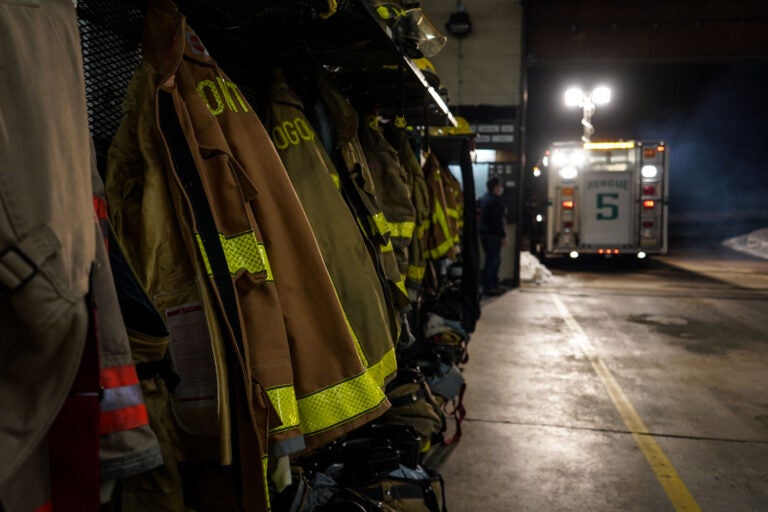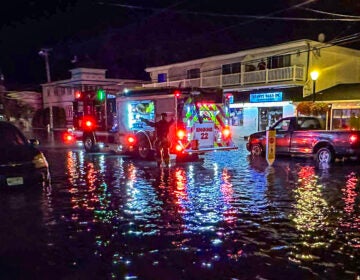Delaware task force offers recommendations to address dwindling volunteer firefighter force
A 12-page document from the Volunteer Firefighter Recruitment and Retention Task Force suggests such inducements as tax credits and tuition reimbursement.

File photo: Volunteer firefighter coats line the wall. (Kenny Cooper/WHYY)
A task force of legislators, emergency responders, and firefighters in Delaware have published recommendations to address a shortage of volunteer firefighters in the state.
The 12-page document outlines several recommendations to recruit and retain volunteers. Those include increasing tax credits, providing tuition reimbursement, adding public safety courses in Delaware’s vocational high schools, and launching a marketing campaign to promote the benefits of volunteer fire service to young people.
The Delaware General Assembly formed the Volunteer Firefighter Recruitment and Retention Task Force in 2019 to address a declining number of volunteer firefighters.
Enrollment in the entry-level training course offered by the Delaware State Fire School fell to fewer than 190 participants in 2019 — less than half the number who took the course a decade earlier. The decline mirrors national trends, according to a 2017 report by the National Fire Protection Association.
“Part of the problem with this is, in the past, traditionally, it used to be a member of the family, certain generations would pass it down to those people in the family, and later generations would join the company. That’s not happening too much anymore,” said State Sen. Bruce Ennis, co-chair of the task force and a life member of Citizens’ Hose Company No. 1 in Smyrna.
Warren Jones of the Delaware Volunteer Firefighters Association pointed to a number of other contributors to the shortage: “Apathy, people coming into the state thinking that the fire service is a paid organization by municipalities, younger people having a lot more to do today than they did 20 years ago…”
The first formally organized all-volunteer fire company in the American colonies was launched in Philadelphia in 1736 by Benjamin Franklin. The first volunteer fire company in Delaware, the Friendship Fire Company in Wilmington, was organized in 1775.
Fire, rescue, and emergency medical services in Delaware are mostly provided by volunteer fire departments. Delaware is the only U.S. state that uses volunteer firefighters in its capital city, Dover. Wilmington has the only fully paid fire department in the state.
Though the number of volunteer firefighters has declined over the years, the number of emergency calls has tripled in the last 30 years.
“The way we’re increasing call volume, we’re going to need more and more EMTs down the road here, and by maintaining a level of volunteer firefighters, we can keep that pool growing,” Jones said.
Volunteer fire companies have compensated for the shortage by hiring a few career staff, such as firefighter EMTs, and relying on neighboring fire companies when responding to emergencies.
The task force recommends developing a recruitment and retention training class at the Delaware State Fire School to share best practices across departments.
It suggests establishing an AmeriCorps program through the Department of Health and Social Services’ Volunteerism Office that would assign full-time members to companies in all three counties, with stipends paid by county governments. A training administrator position would be created within the Delaware State Fire School to manage the AmeriCorps program.
Task force members also recommend expanding the Sussex County Operation GEM cadet firefighter program, which trains children ages 10 to 15.
Marketing, such as a recruitment website, and promoting the benefits of becoming a volunteer firefighter would help attract more people, the task force said, and public safety classes offered by Delaware’s vocational technical school districts would make volunteer firefighting more accessible.
Other recommended incentives include making Delaware State Fire School courses eligible for college credits, offering tuition reimbursement to undergraduate and graduate students attending higher education institutions in the state who volunteer with a local fire company for a set number of hours, and increasing the income tax credit available to volunteer fire company members from $400 to $1,000.
Tuition reimbursement and the increased tax credit would require the General Assembly to pass legislation. But Ennis said the state’s joint finance committee has already set aside $175,000 that can be allocated for students who want to get involved in fire-related career training.
The state’s Office of Management and Budget has already set aside funding for a full-time position to manage the AmeriCorps program.
“College tuition is certainly important to most people today, and most young people coming out of high school today. So that’s a big benefit there,” Jones said. “And by using the AmeriCorps program and the members of AmeriCorps, we will get people out on the street who can promote the volunteer fire service, and hopefully promote getting more people into the volunteer fire [service].”
There are several reasons why Jones and Ennis say making volunteer fire departments more robust is important for the community.
Delaware’s state auditor reports that the volunteer system has saved residents more than $244 million.
There are more than 1,500 full-time EMTs in Delaware, most of whom began their careers with the volunteer fire service. Ennis said several fire marshals, nurses, and 911 dispatchers also are former volunteer firefighters.
“So this is just a baseline for public safety, and if you don’t have the volunteers, you’re gonna lose that,” he said.
Anyone interested in becoming a volunteer firefighter can visit Firefighter.delaware.gov.

Get daily updates from WHYY News!
WHYY is your source for fact-based, in-depth journalism and information. As a nonprofit organization, we rely on financial support from readers like you. Please give today.







